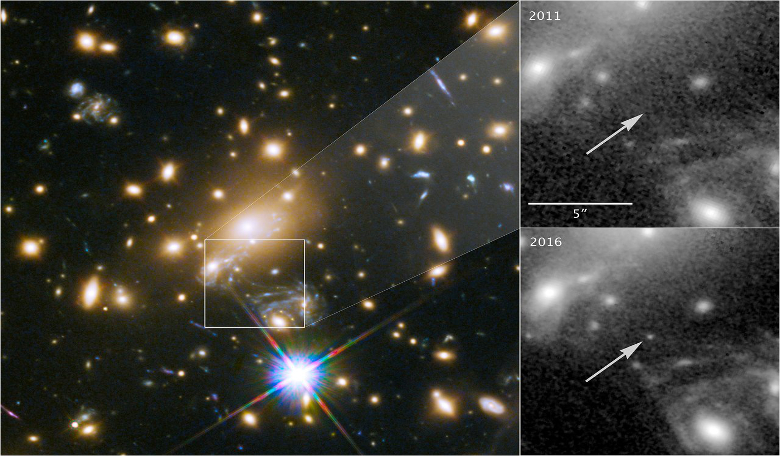Astronomers tracking a supernova explosion have unexpectedly found the most distant star ever discovered; a hot blue star that existed when the Universe was only about 30 percent of its current age – about 4.4 billion years after the Big Bang.
Light from such a distant source would normally be incredibly difficult if not impossible to spot, however the international team of astronomers that found it had a helping hand from an effect known as gravitational lensing.
Gravitational lensing occurs when the mass in a foreground object such as a galaxy, magnifies the light from a fainter object in the background by refocusing it elsewhere.
It works in a similar principle to how normal lenses in a pair of glasses or a magnifying glass work - light that is passed through the lens bends and is refocused elsewhere in a process known as refraction. In a pair of glasses, the light is refocused in your eye, but in the case of gravitational lensing it is the gravitational field of a massive object that causes any light rays passing close by to be bent and refocused somewhere else. The process was first predicted by Albert Einstein and is now used to find some of the most distant objects in the Universe.
For the newly lensed stellar discovery, now aptly named Lensed Star 1 (LS1), it was found because it’s light was magnified 2000 times greater than normal and Hubble just happened to be poking around in the same galaxy looking for something else.
The space telescope had originally been set up to observe a gravitationally lensed supernova explosion nicknamed “Refsdal” in the galaxy cluster MACS J1149-2223, when it unexpectedly picked up the LS1 point source. The light from LS1 was magnified not only by the huge total mass of the galaxy cluster, but also by another compact object thought to be either a star, a neutron star, or a stellar-mass black hole about three times the mass of the Sun within the galaxy cluster itself.
When the lensing object is something smaller such as a star or sometimes even a planet, the process is still the same but the terminology changes to reflect the smaller lensing source and it is known as microlensing instead.
“Like the Refsdal supernova explosion the light of this distant star got magnified, making it visible for Hubble,” says Patrick Kelly from the University of Minnesota, USA, and the lead author of the research recently submitted to Nature Astronomy. “This star is at least 100 times farther away than the next individual star we can study, except for supernova explosions.”
Researchers think that LS1 is a B-type supergiant star - an extremely luminous, short-lived star that can have surface temperatures between 11 000 and 14 000 degrees Celsius making it blue in colour.
“The discovery of LS1 allows us to gather new insights into the constituents of the galaxy cluster. We know that the microlensing was caused by either a star, a neutron star, or a stellar-mass black hole,” explains Steven Rodney from the University of South Carolina, USA and a co-author of this research.
Those latter two constituents are classed as dark objects and being dark they are notoriously difficult to find. It has been suggested that dark objects such as the one that might have been a lensing object for LS1 make up a high fraction of dark matter, however, after analysing the light from LS1 the team state that their observations do not favour this possibility, at least not if the dark objects are primordial black holes with about 30 times the mass of the Sun or less.
Nonetheless, once the James Webb Space Telescope gets off the ground, the team suggest that with microlensing, it will be possible to study the evolution of the earliest stars in the Universe in greater detail than ever before and more insight as to the nature of dark matter could also be subsequently revealed.











